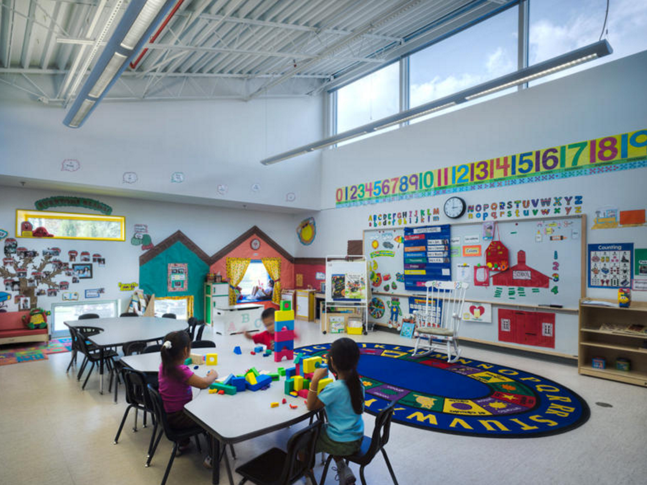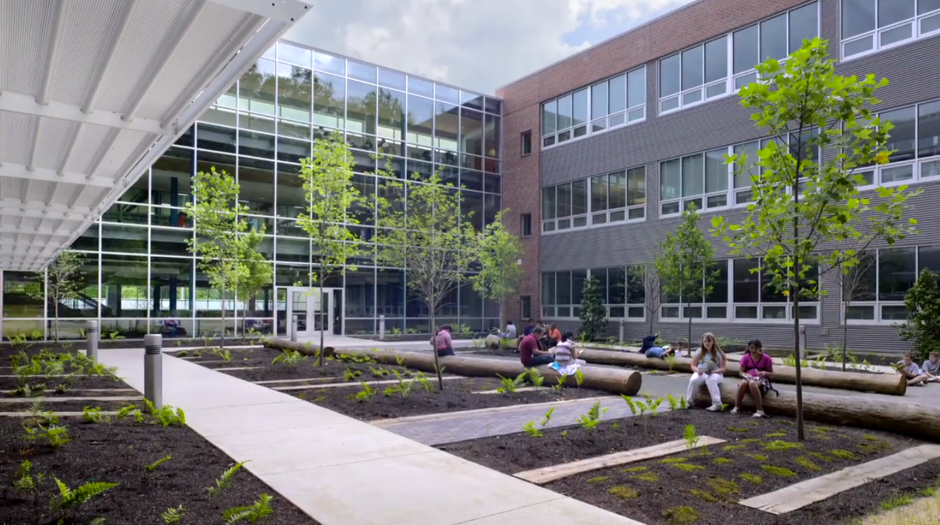|
|
Student Corner: Biophilic Design, Part II: Case StudyBy CED Program Interns & StudentsPublished December 15, 2016
Manassas Park Elementary School Manassas Park Elementary School, located in Manassas Park, Virginia, was chosen for this case study because it illustrates the many simple ways that biophilic design can be incorporated into buildings. Manassas Park Elementary features naturally lit classrooms, large windows with views of nature, and outdoor learning spaces. The architects at VMDO chose these biophilic features in an effort to create the best possible environment for children and teachers. While this case study focuses on a school environment, the biophilic design features can be applied to other building types, such as offices, stores, hospitals, and homes. Views into Nature Learning spaces are provided near large windows. Below, students enjoy reading near south-facing windows, which provide the maximum amount of sunlight. This improves student performance and concentration and can lower electricity usage by decreasing the need to have the lights on. The views into nature serve to lower the barrier between the building’s occupants and outdoors. Views such as this one have been shown to improve test scores and increase productivity. Natural Light Design elements throughout the school enhance and spread natural light throughout the building. In the first photo below, the ceiling is white and slopes down to best reflect light coming in through the north-facing windows. Children in this classroom enjoy the kid-size window nooks on the far wall which provide eye-level views outdoors for the children. Materials used throughout the school were selected to best reflect light. The bottom photo shows mirrors placed in hallways to reflect light spilling out from the classrooms. Other design elements chosen for this purpose include tiled floors, which reflect light better than carpet, and frosted or glazed glass, which is selected for rooms that require privacy and sunlight. Natural Elements and Materials When possible, natural materials are selected over metal or synthetic materials. Wood is featured throughout the classroom – in the ceiling, floor, and doors – which helps to bring the outdoors in while easing the visual transition from the trees (viewed through the large window) to the classroom. These features help to energize students and staff and reduce stress levels. Recuperative Natural Spaces The landscaping highlighted below shows how benches (tree trunks) have been placed among trees and plants to invite students to turn outdoor spaces into places of relaxation, rather than simply walking routes between the classroom and parking lot. Recuperative spaces with pleasant views, such as this one, can help to reduce absenteeism and improve morale among students and teachers. Indoor Plants Perhaps the simplest of biophilic design features is house plants. They create visual interest, improve air quality, boost concentration and act as a sound absorber. Caring for a houseplant is also therapeutic and has been shown to boost happiness. House plants are a great way to start benefiting from biophilic design wherever you work. For a more in-depth look at the biophilic features of Manassas Park Elementary School, check out this video. Photos above were retrieved from this video and this website. Luke Patton is a second-year business student at the UNC Kenan-Flagler Business School and is currently a Fellow with the Development Finance Initiative. |
Published December 15, 2016 By CED Program Interns & Students
 Note: This is the second of three blog posts on biophilic design, a design philosophy that seeks to incorporates nature into man-made spaces. Part 1 introduced the topic of biophilic design. This post, Part 2, discusses a case study on biophilic design. Part 3 will explore the idea of biophilic cities.
Note: This is the second of three blog posts on biophilic design, a design philosophy that seeks to incorporates nature into man-made spaces. Part 1 introduced the topic of biophilic design. This post, Part 2, discusses a case study on biophilic design. Part 3 will explore the idea of biophilic cities.
Manassas Park Elementary School
Manassas Park Elementary School, located in Manassas Park, Virginia, was chosen for this case study because it illustrates the many simple ways that biophilic design can be incorporated into buildings. Manassas Park Elementary features naturally lit classrooms, large windows with views of nature, and outdoor learning spaces. The architects at VMDO chose these biophilic features in an effort to create the best possible environment for children and teachers. While this case study focuses on a school environment, the biophilic design features can be applied to other building types, such as offices, stores, hospitals, and homes.
Views into Nature
Learning spaces are provided near large windows. Below, students enjoy reading near south-facing windows, which provide the maximum amount of sunlight. This improves student performance and concentration and can lower electricity usage by decreasing the need to have the lights on. The views into nature serve to lower the barrier between the building’s occupants and outdoors. Views such as this one have been shown to improve test scores and increase productivity.
Natural Light
Design elements throughout the school enhance and spread natural light throughout the building. In the first photo below, the ceiling is white and slopes down to best reflect light coming in through the north-facing windows. Children in this classroom enjoy the kid-size window nooks on the far wall which provide eye-level views outdoors for the children.
Materials used throughout the school were selected to best reflect light. The bottom photo shows mirrors placed in hallways to reflect light spilling out from the classrooms. Other design elements chosen for this purpose include tiled floors, which reflect light better than carpet, and frosted or glazed glass, which is selected for rooms that require privacy and sunlight.
Natural Elements and Materials
When possible, natural materials are selected over metal or synthetic materials. Wood is featured throughout the classroom – in the ceiling, floor, and doors – which helps to bring the outdoors in while easing the visual transition from the trees (viewed through the large window) to the classroom. These features help to energize students and staff and reduce stress levels.
Recuperative Natural Spaces
The landscaping highlighted below shows how benches (tree trunks) have been placed among trees and plants to invite students to turn outdoor spaces into places of relaxation, rather than simply walking routes between the classroom and parking lot. Recuperative spaces with pleasant views, such as this one, can help to reduce absenteeism and improve morale among students and teachers.
Indoor Plants
Perhaps the simplest of biophilic design features is house plants. They create visual interest, improve air quality, boost concentration and act as a sound absorber. Caring for a houseplant is also therapeutic and has been shown to boost happiness. House plants are a great way to start benefiting from biophilic design wherever you work.
For a more in-depth look at the biophilic features of Manassas Park Elementary School, check out this video. Photos above were retrieved from this video and this website.
Luke Patton is a second-year business student at the UNC Kenan-Flagler Business School and is currently a Fellow with the Development Finance Initiative.
Author(s)
Tagged Under
This blog post is published and posted online by the School of Government to address issues of interest to government officials. This blog post is for educational and informational Copyright ©️ 2009 to present School of Government at the University of North Carolina. All rights reserved. use and may be used for those purposes without permission by providing acknowledgment of its source. Use of this blog post for commercial purposes is prohibited. To browse a complete catalog of School of Government publications, please visit the School’s website at www.sog.unc.edu or contact the Bookstore, School of Government, CB# 3330 Knapp-Sanders Building, UNC Chapel Hill, Chapel Hill, NC 27599-3330; e-mail sales@sog.unc.edu; telephone 919.966.4119; or fax 919.962.2707.






